
At Banthum School (Thum Prachanukroh) in Khon Kaen Province, one of the schools in the Teacher and School Quality Program or TSQP Generation 1, supported by the Equitable Education Fund (EEF) Thailand, the division between ‘front-row students’ and ‘back-row students’ has been effectively eliminated. The phrase “no child is left behind” has been set as the learning goal. This creates a space where teachers can train and experiment to become ‘learning managers’, transforming students into ‘active learners’ who gain knowledge from their surroundings. This involves observing, questioning, and seeking answers, which fosters the development of individual experiences, enabling every child in the classroom to achieve the learning objectives together.
In the self-development classroom at Banthum School (Thum Prachanukroh), the divide between ‘front-row students’ and ‘back-row students’ has been eliminated through the ‘Open Approach’. This teaching method utilizes open-ended problems to drive student engagement, accompanied by ‘Lesson Study’, where a ‘team of teachers’ collaboratively observes, records, and reflects on classroom activities weekly. This fosters a dialogue that leads students to think, analyze, and solve problems independently, creating personalized knowledge that can be applied in daily life and further advanced learning.
In this article, EEF invites everyone to visit and learn from the ‘model classroom for reducing disparities’ in the Social Studies subject with the learning unit ‘Less Waste, Less Problems’, demonstrating that transformative learning management that effectively transforms students has no limitations.
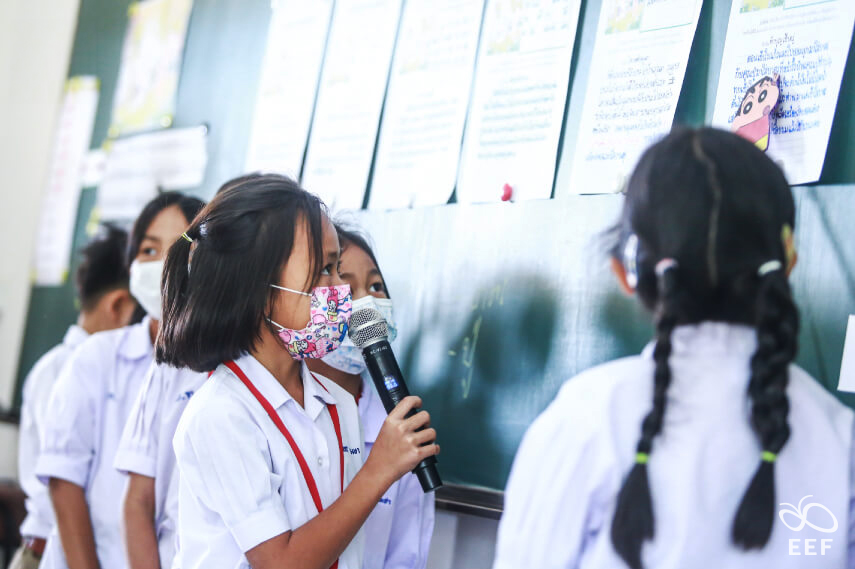
In modern classrooms, rote memorization of knowledge is considered ‘outdated’.
Before visiting the ‘Showcase’ model classroom, let’s get acquainted with Banthum School (Thum Prachanukroh). This medium-sized school, occupying 38,400 square meters, has 38 teachers looking after students from kindergarten through 6th grade, totaling 728 students, located in an agricultural area. The school has advanced teaching methods that have transformed the learning outcomes in Thai, English, and Science from below the national average to above the national average within three years. The school also shows improved O-net test results.
Since 2019, Banthum School (Thum Prachanukroh) has participated in the Teacher and School Quality Program, or ‘TSQP’ Generation 1, supported by EEF Thailand. The aim is to enhance the quality of education in about 700 small and medium-sized schools under the OBEC, enabling them to develop holistically through the Whole School Approach. This includes management systems and classroom teaching methods to equip students with essential skills for living in today’s world and prepare them for future changes.
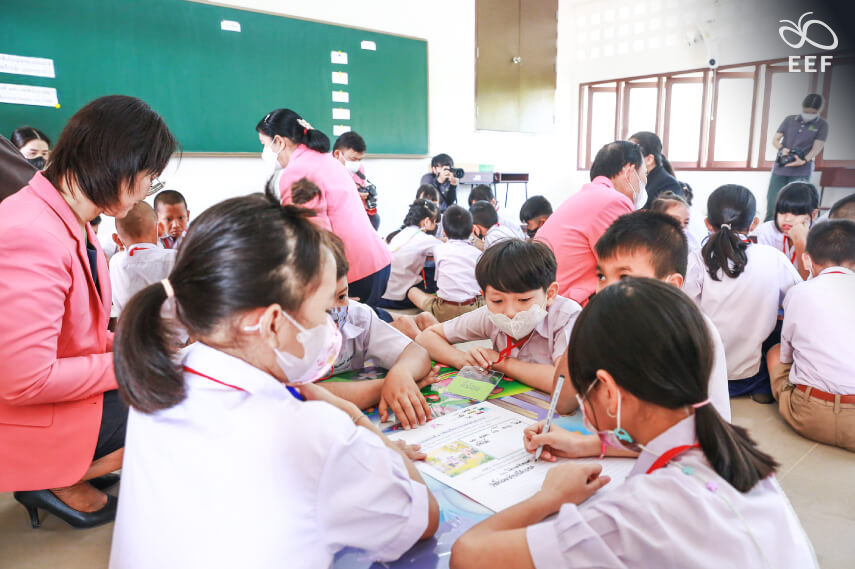
Assoc. Prof. Dr. Maitree Inprasitha, Vice President of Education and Academic Services at Khon Kaen University, one of the partners of the EEF, who leads the development of teaching methods to transform the children’s learning process said that Banthum School uses a method called ‘Open Approach’. This method involves learning management where teachers use open-ended problems to drive the learning process of students, accompanied by the ‘Lesson Study’ method in which a team of teachers observe and record classroom activities to engage in a process of joint reflection or what is called a ‘Professional Learning Community’ (PLC) weekly.
“The traditional teaching methods that rely on rote memorization are becoming outdated because modern educational quality requires children to think, analyze, and solve problems independently. However, to achieve this, we must systematically change the teaching methods. The important point is that development does not necessarily require a large budget or resources, just appropriate methods and serious cooperation from school personnel at all levels. Schools participating in the TSQP program have shown that success can be achieved.”
“Importantly, this process can be adapted for use in schools of all levels and sizes, helping to reduce the disparity in educational quality between urban and remote areas. Therefore, it is one of the methods that EEF Thailand has adopted in collaboration with Khon Kaen University to improve the quality of schools in this program.”
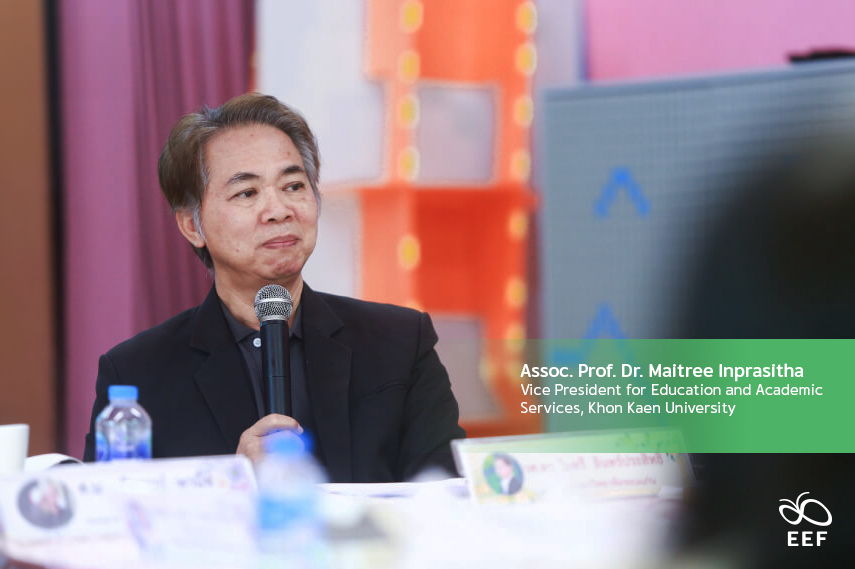
Exploring Grade 5 classroom to observe the learning unit ‘Less Waste, Fewer Problems’.
After the overview of the TSQP program, Ms. Karnnikar Keskhomkhwaa, the social studies teacher at Banthum School, took us to the Grade 5 classroom to observe the learning unit ‘Less Waste, Fewer Problems’, which aims to teach children how to reduce waste, choose appropriate waste management methods, and understand the importance of reducing waste.
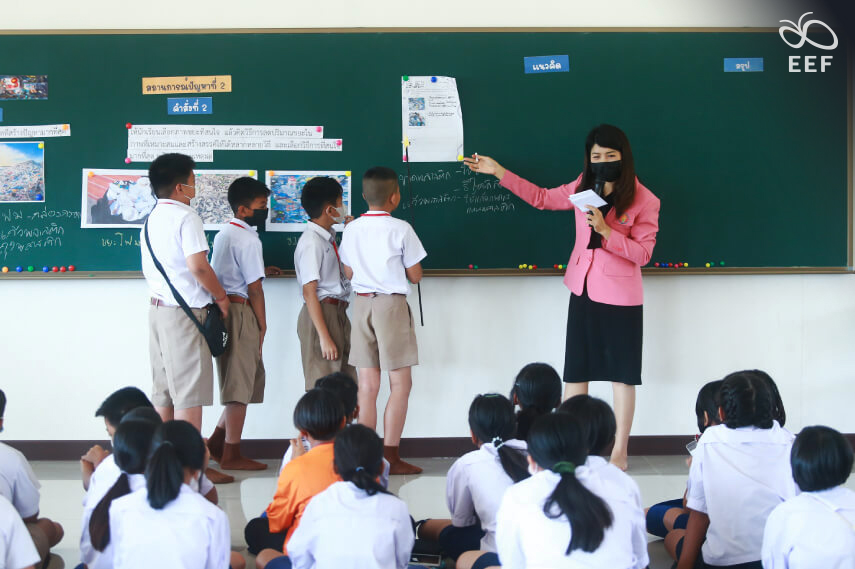
Ms. Karnnikar emphasized that the Open Approach is about ‘changing the teaching method’ from the traditional direct transfer of knowledge from teachers to students to a four-step process:
1. Create problems that are observable in real life and relevant to the students.
2. Use these problems in the classroom and let students learn to solve them independently.
3. The teacher observes the students’ ideas on the solutions to these problems.
4. The students must discuss the solutions they have found and summarize the results into ‘lessons learned.’
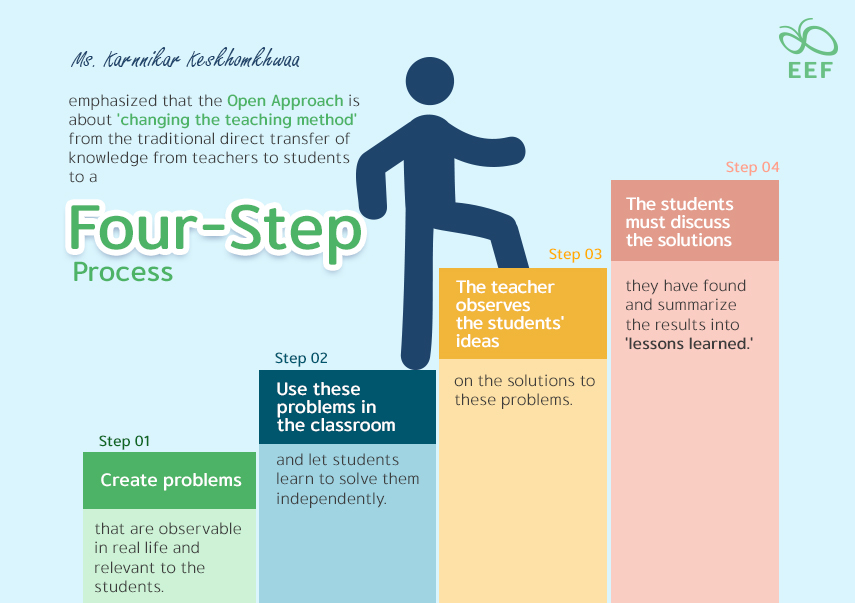
In this class, Ms. Karnnikar started by greeting the children and discussing the changing weather resulting from environmental changes. She asked them to tell if any of their classmates were absent due to illness to draw attention to relatable issues. Then, she discussed how the increasing illnesses today result from worsening environmental conditions. At this point, she asked, “What can you all do to improve the world?”

To stimulate the children’s interest, the teacher used real-life images from the community to connect and show how changes in the world will ultimately affect everyone. Then, starting with an initial question, the students were asked to think about which types of waste create the most problems. Once an answer was obtained, the teacher divided the children into groups to choose an image they were interested in and collectively brainstorm about various appropriate ways to reduce waste. Each group selected their favorite method to explain their reasoning to the class.
“The classroom process is divided into 6 steps: 1. Prepare the children for the lesson.
2. Present the problem.
3. Proceed with problem-solving.
4. Reflect on your thoughts.
5. Discuss and summarize.
6. Evaluate the outcomes.
The children would start by thinking and helping each other gather information. In this class, it can be observed that many children can connect their own experiences of managing waste at home and share these with their peers. For example, some might use waste for composting at home, or those with smartphones might help others look up information discussing interesting topics. This opens up pathways to new knowledge. Furthermore, the children would discuss and explain the appropriate ways to manage waste within their groups. Meanwhile, the teacher would observe and record the students’ ideas, offering guidance and helping to broaden their perspectives to develop their ideas further.”
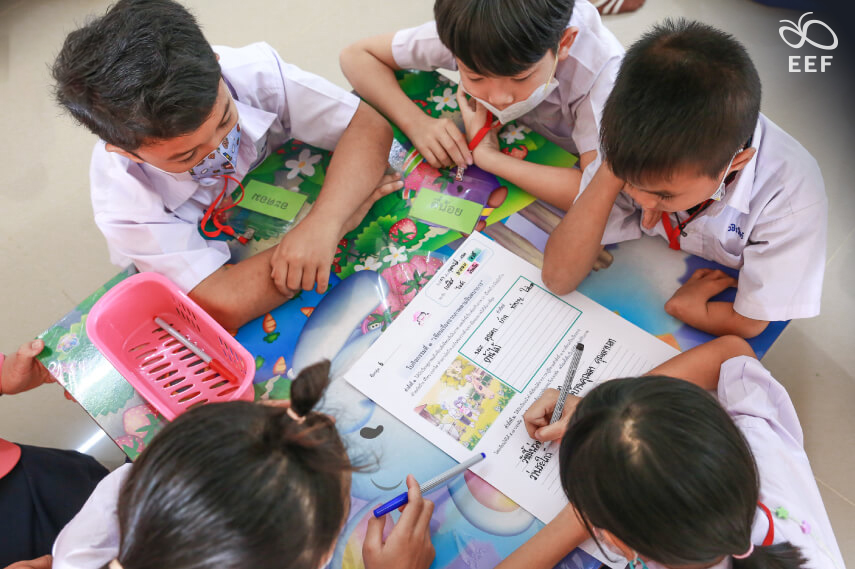
After the presentation and discussion, the final step was the evaluation, where the children would assess their work to determine their level and how satisfied they were, such as what score out of ten they thought their group deserved. Then, the teacher would evaluate the student’s work based on each group’s written description, use of drawings or symbols, and explanation of the problem-solving process, combined with presentation techniques in front of the class and expressing opinions to collectively build knowledge within the group, before the final evaluation of desired qualities and competencies of the learners.
Ms Karnigar summarized the learning process, “With learning steps that allow everyone to think, analyze, deliberate, brainstorm, explain, and synthesize on their own, the lessons that are jointly conceived and presented will become ingrained in the children. This also helps to create new knowledge about waste management and sorting techniques that can be applied in real life and communicated with family members.”
Regardless of where the school is located, there should be no restrictions on development.
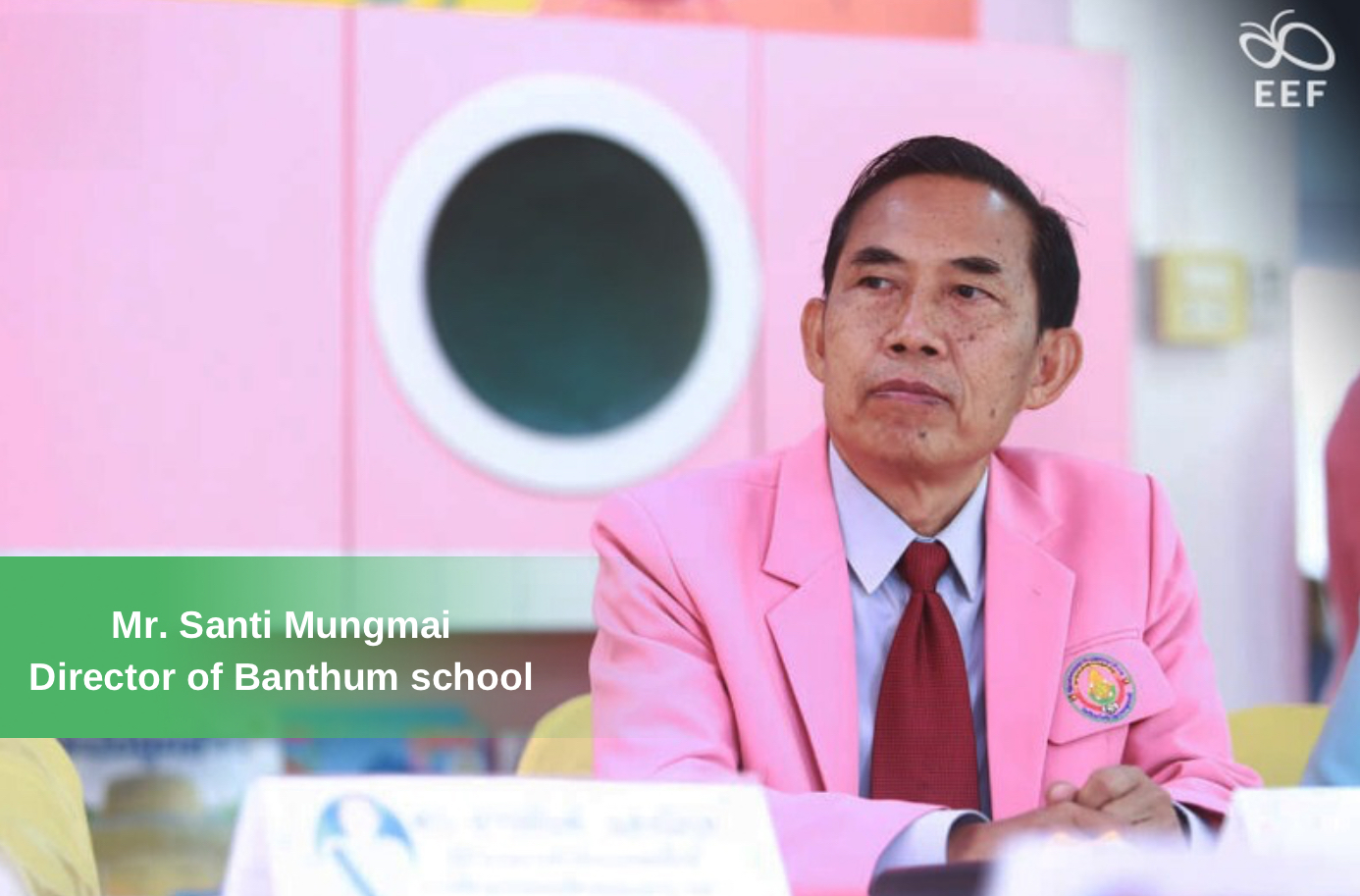
Before the model classroom hour ended, Mr. Santi Muangmai, the Director of Banthum School, emphasized the core concept of the Open approach classroom as ‘transforming’ the method of ‘teaching’ into ‘learning’ which leads to the development of independent thinking, analytical and problem-solving skills for children, and simultaneously develop teachers’ learning management skills. The challenge for the school in the Teacher and School Quality Program lies in the complexity of each classroom, necessitating different methods of working and problem-solving. The school personnel must understand that flexible educational management continuously requires updating and adapting lessons to integrate with current situations. We are not striving to have the ‘best classroom.’ Still, we are turning the classroom into a space for teachers to experiment with learning management development and transform students into active learners through hands-on practice, gaining specific experiences that can be applied in real life.
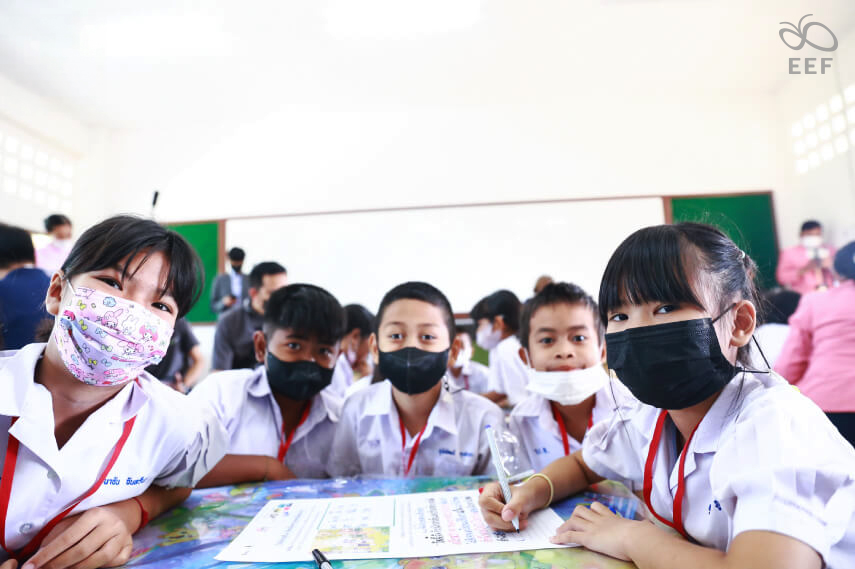
Prof. Vicharn Panich, M.D., Chairman of the Whole School ApproachSub-Committee of EEF, stated that the model classroom at Banthum School proves that although the TSQP program has concluded, the deeply rooted work of enhancing educational quality continues to grow. This is an example of the culture of horizontal advancement of the Thai educational system, where teachers, administrators, schools, local agencies, and communities lead the change. All parties’ collaboration, joint action, and shared ideas demonstrate that there are no limits to the transformative learning management that effectively transforms students. The diversity of innovations and the endless collaborative educational network are significant lessons for other schools in the country to adapt and develop according to their contexts.
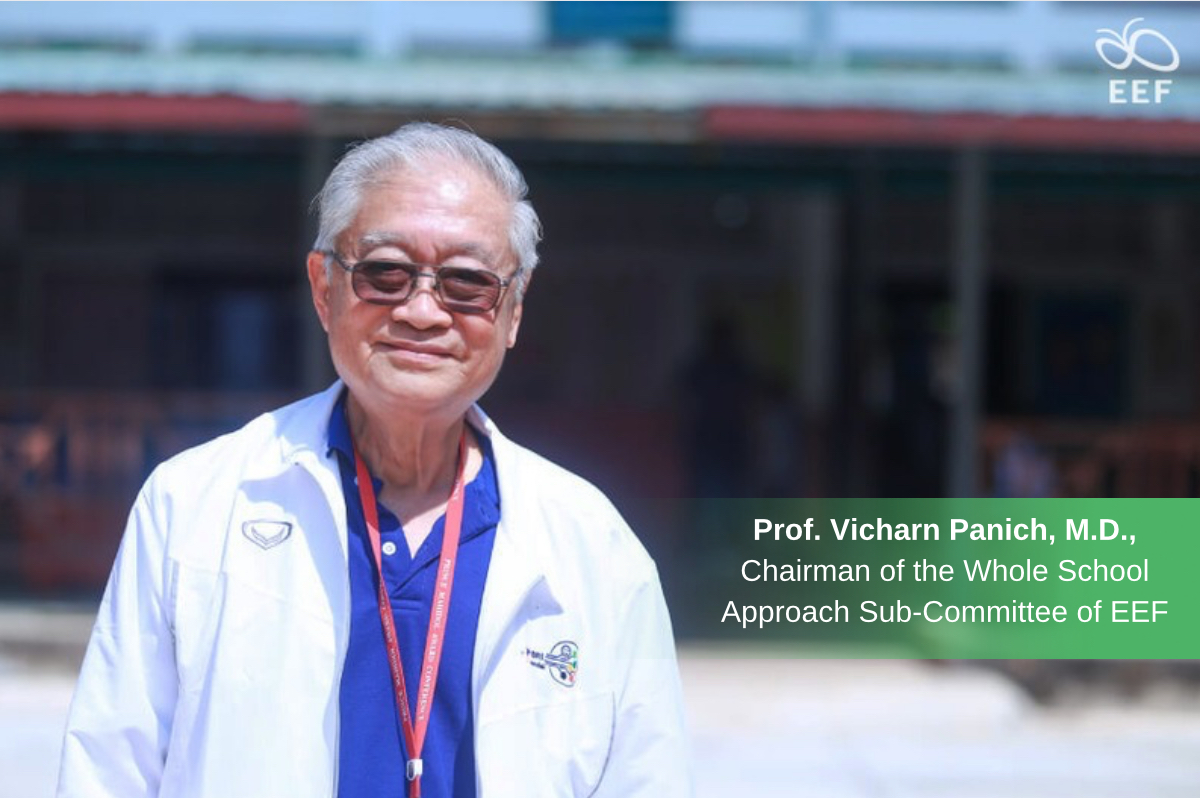
The ultimate goal of the TSQP program by EEF is to explore various models and contexts to derive lessons and create tools to ‘transform education’ that every school in Thailand can use. This ensures that from now on, every child in every classroom will have a similar level of learning development, with no one being left behind. It affirms that ‘learning has no limits, regardless of where the school is located in the country.’
Credit: Rawis Larha | Content and Writer Production Officer
Source: (TSQP) Self-Development Classroom at Banthum School (Thum Prachanukroh), Khon Kaen Province

